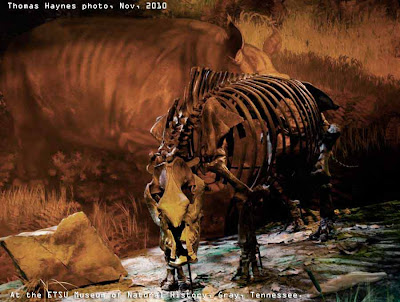Follow the Photographs to Learn Part of the
Gray Fossil Site Story.
It started in year 2000 when a crew was working to improve the road and came upon soil that seemed out of place. In the soil were found fragments of bones and plant remains. Fortunately, East Tennessee State University was nearby and with the fossil site confirmed, a new university department was developed and the laboratory was the Miocene fossil dig near the town of Gray. Students at the university now have hands-on experience in the recovery, identification and preservation of prehistoric remains. Like a dream come true, a new professor soon had his own department at the University, along with museum and on-site facilities. This appears a win-win for paleontology (and associated sciences) as well as for the university, students, perhaps for a local farm and for those state government people assigned to promoting tourism in the state of Tennessee.
Shown under construction 1 year ago, the educational and visitor annex to the East Tennessee State University and General Shale Brick Natural History Museum is now open. Paleontology is fascinating to school children and the annex is provided with a classroom to accommodate 100.
The fossil site is a prime location for school field trips
and is a hands-on laboratory for ETSU students.
The fossil site is a prime location for school field trips
and is a hands-on laboratory for ETSU students.
The Miocene Epoch is said to cover time from 23.8 to 5.3 million years ago. The Gray Fossil Site is said to be from the late part of that epoch, only 7 to 5.3 million years ago. Yikes, that is recent!
Bones found are not turned to rock as commonly thought in fossils. These are actual bones and must be carefully preserved. Using what is apparently cold molding compounds, molds are made of the relics and then copies are cast in the molds. The original bones are much too fragile and valuable to be assembled into a mock-up of a prehistoric animal, therefore the castings are used for this purpose. Great care is required to make the fossil bone castings as close to the appearance of original bones as possible.
Links below tell much more about the find than I do here on the blog. There are no dinosaurs in the find because it is much too young in prehistoric years. The animals are types of ancient camels, rhinos, bears, tapirs, sloths, turtles, lizards and others. There are even prehistoric panda bones including the skull.
The original hole is in the rear with the unusual dark soil showing. At middle right is a test hole.
Shown full of water run-off, this is a productive pit. A prehistoric Rhinoceros was found here. When weather allows continued digging, who knows what prehistoric creature may be found.
Skull and jawbone of prehistoric Bristol Panda found at the Gray fossil site
with modern bones for comparison
This information below is quoted directly from the “Educator’s Guide” which may be downloaded from the Gray Fossil Site website at the link shown: “The Tennessee Department of Transportation (TDOT) discovered the Gray Fossil Site in May 2000 during routine road construction. Workers uncovered a deposit of soft black clay that is not typically seen in our region. They found that the black clay was not suitable for road construction so they called in TDOT geologists for technical advice.
The geologists examined the black clay deposit and found a large number of animal bones and plant remains. They also discovered that the deposit was layered in the same manner as pond or lakebed sediments. These lacustrine (or lake formed) sediments accumulate in slack or still water from silt that sinks to the bottom of the body of water. Leaves and twigs also sink to the bottom adding to the organic ooze. This ooze provides an excellent environment for the preservation and fossilization of plant and animal remains….”
http://www.grayfossilmuseum.com/?BISKIT=3085743966&CONTEXT=cat&cat=102
The man in the middle left is working on assembly of parts of a tortoise or turtle shell found broken and partially crushed. Can you imagine the precise work needed to do this job and the patience required by the student worker?
This is a cast replica of a Rhino skull. You will see assembled skeleton forms of several types of animals at the museum. The white containers are safe storage for the many fossil remains found in the black clay at the dig.
A GOOD WIKI ARTICLE ON THE GRAY FOSSIL SITE:
http://en.wikipedia.org/wiki/Gray_Fossil_Site
The photographs in the blog post are from a visit in November 2010. I wonder how the same places look now, one year later?
As we left, there in a field next to the Museum boundary was a home made sign. It said something like The Fulkerson Farm Fossil Site. .
In September of 2011, a press announcement stated that acreage was purchased from the Fulkerson Farm by the Museum to allow fulfillment of coming development.
Link to the press article with photos: http://www.johnsoncitypress.com/Living/article.php?id=94254
This view is beside and looking beyond the fossil site toward farmland in the distance. Dirt first excavated for the road project was put here and all will eventually be sifted and examined for the tiniest fossil relics. The yellow bags in the left are full of soil awaiting further examination.
--------------------------
Thomas Haynes is a photographer working out of Clinton, Tennessee, a city just north of Knoxville. His photography is often of a fine arts direction but as in this post, his love of nature takes him again to the Clinch River Raptor Center, a rehabilitation and educational not-for-profit organization.. Visit Thomas and see more of his photography at Facebook
Contact Thomas to discuss photography you want done.
_______________________________________








No comments:
Post a Comment